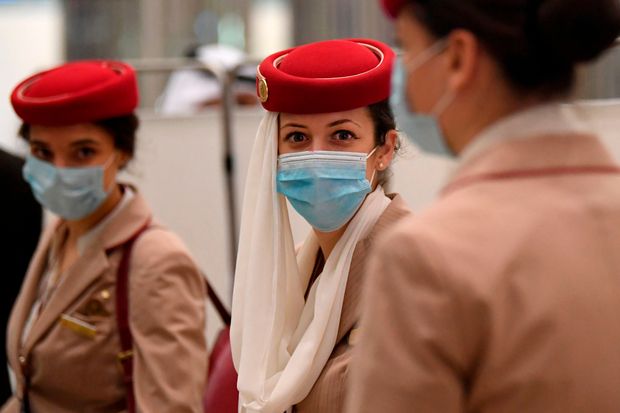The International Air Transport Association (IATA) announced global passenger traffic results for March 2020 showing that demand (measured in total revenue passenger kilometres or RPKs) dived 52.9% compared to the year-ago period. This was the largest decline in recent history, reflecting the impact of government actions to slow the spread of COVID-19. In seasonally adjusted terms, global passenger volumes returned to levels last seen in 2006. March capacity (available seat kilometres or ASKs) fell by 36.2% and load factor plummeted 21.4 percentage points to 60.6%.
“March was a disastrous month for aviation. Airlines progressively felt the growing impact of the COVID-19 related border closings and restrictions on mobility, including in domestic markets. Demand was at the same level it was in 2006 but we have the fleets and employees for double that. Worse, we know that the situation deteriorated even more in April and most signs point to a slow recovery,” said Alexandre de Juniac, IATA’s Director General and CEO.
| march 2020 (% YEAR-ON-YEAR) | world share1 | rpk | ask | PLF (%-PT)2 | PLF (LEVEL)3 |
| Total Market | 100.0% | -52.9% | -36.2% | -21.4% | 60.6% |
| Africa | 2.1% | -44.6% | -34.4% | -11.3% | 60.9% |
| Asia Pacific | 34.7% | -59.9% | -44.4% | -22.8% | 58.9% |
| Europe | 26.8% | -51.8% | -39.7% | -16.8% | 67.0% |
| Latin America | 5.1% | -39.3% | -27.2% | -13.5% | 68.1% |
| Middle East | 9.0% | -46.0% | -33.6% | -13.8% | 59.9% |
| North America | 22.2% | -49.8% | -22.8% | -29.9% | 55.7% |
1-% of Industry RPKs in 2019 2-Year-on-year change in load factor 3-Load factor level
International Passenger Markets
March international passenger demand shrank 55.8% compared to March 2019. That is much worse than the10.3% year-to-year decline in February. All regions recorded double-digit percentage traffic declines. Capacity tumbled 42.8%, and load factor plunged 18.4 percentage points to 62.5%.
Asia-Pacific airlines led the decliners, as March traffic dropped 65.5% compared to the year-ago period, which was more than double the 30.7% decline in February. Capacity fell 51.4% and load factor collapsed 23.4 percentage points to 57.1%.
European carriers saw March demand fall 54.3% year-to-year. In February, traffic was virtually flat compared to February the prior year. Capacity dropped 42.9%, and load factor sank 16.8 percentage points to 67.6%, which was the highest among regions.
Middle Eastern airlines posted a 45.9% traffic decrease in March, reversing a 1.6% increase in February. Capacity slid 33.5%, and load factor dropped 13.7 percentage points to 59.9%.
North American carriers’ traffic dived 53.7% compared to March a year ago, dramatically worsened from a 2.9% drop in February compared to February 2019. Capacity fell 38.1%, and load factor sank by 21.1 percentage points to 62.8%.
Latin American airlines experienced a 45.9% demand drop in March, compared to the same month last year; in February traffic declined 0.2% year-to-year. Capacity fell 33.5% and load factor sagged 15.3 percentage points to 66.5%.
African airlines’ traffic fell 42.8% in March, which was a huge deterioration from a 1.1% decline in February. Capacity dropped 32.9%, and load factor contracted 10.5 percentage points to 60.8%.
Domestic Passenger Markets
Demand for domestic travel shrank 47.8% in March compared to March 2019 with double-digit percentage declines in all markets. This compared to a 21.3% year-to-year decline in February. Capacity fell 24.5% and load factor plunged 26.0 percentage points to 58.1%.
| March 2020 (% YEAR-ON-YEAR) | world share | rpk | ask | PLF (%-PT)2 | PLF (LEVEL)3 |
| Domestic | 36.2% | -47.8% | -24.5% | -26.0% | 58.1% |
| Dom. Australia | 0.8% | -40.2% | -25.2% | -15.9% | 63.4% |
| Domestic Brazil | 1.1 | -32.2% | -24.0% | -8.7% | 72.2% |
| Dom. China P.R. | 9.8% | -65.5% | -51.4% | -24.7% | 60.2% |
| Domestic India | 1.6% | -11.8% | 0.7% | -10.7% | 76.0% |
| Domestic Japan | 1.1% | -55.8% | -14.3% | -36.7% | 39.0% |
| Dom. Russian Fed. | 1.5% | -15.4% | 5.2% | -15.8% | 64.6% |
| Domestic US | 14.0% | -48.1% | -14.7% | -33.9% | 52.9% |
1-% of Industry RPKs in 2019 2-Year-on-year change in load factor 3-Load factor level
Chinese airlines continued to see the steepest declines, with domestic demand down 65.5% in March compared to March 2019. This, however, was an improvement over the 85% year-to-year decline in February as the country began to re-open domestic air travel.
Japan’s airlines recorded a 55.8% year-over-year decline in domestic RPKs, despite not implementing any widespread lock down.
The Bottom Line
“The industry is in free fall and we have not hit bottom. But there will come a time—soon, I hope—when authorities will be ready to begin easing restrictions on mobility and opening borders. It is imperative that governments work with industry now to prepare for that day. It is the only way to ensure that we have measures in place to keep passengers safe during travel and reassure governments that aviation will not be a vector in the spread of the disease. We must also avoid the confusion and complexity that followed 9.11. Global standards that are mutually accepted and operationally practicable will be mission-critical to achieving this. The only way to get there is by working together,” said de Juniac.
About Guide2Uganda
Guide2Uganda (www.guide2uganda.ug) is the most comprehensive source of information about Uganda that exists on the web, with more content on Uganda and surrounding towns, attractions, museums and galleries than any other online guide that currently exists for Uganda as well as being a dynamic news and comprehensive events driven site with content being added daily.
According to WeFollow & Peer Index (whom both measure online influence) we are among the most influential online media organizations in Uganda. We were also awarded for ‘’Best Destination Website in Uganda’’ by Jumia Travel Uganda in the 2017-2018 Africa Travel Awards. If you are planning a visit to Uganda you can always reach us on; info@guide2uganda.ug




